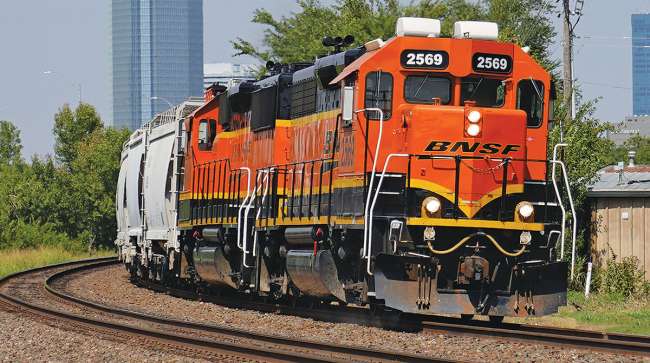Staff Reporter
Hundreds Warn EPA: Don’t Back CARB Ban on Diesel Locomotives

[Stay on top of transportation news: Get TTNews in your inbox.]
Scores of government officials, public agencies and business interests are warning the U.S. Environmental Protection Agency that approving California’s rule to outlaw diesel locomotives will harm the nation’s interconnected rail system.
Such a move, they assert, would disrupt the supply chain, close businesses and force prices to skyrocket.
At issue is the “In-Use Locomotive Regulation” by California Air Resources Board to outlaw diesel emission locomotives. The law, applying to operators of freight linehaul, switch, industrial, passenger and historic locomotives, has several components such as an idling requirement for locomotive shutdowns after idling for 30 minutes.
It also says in six years no locomotives older than 23 years can operate in California except zero-emission ones. Locomotive operators must create annual “spending accounts” starting July 1, 2026, to pay into a restricted trust estimating health costs attributable to their locomotive emissions released the previous year. Also, operators must submit yearly administrative paperwork and pay $175 per locomotive along with annual reports to ensure compliance.
Under the Clean Air Act, EPA was asked by CARB in November to authorize enforcement of the new locomotive law. Federal Register Document 2024-03955 says EPA shall not grant such authorization if it determines California is arbitrary and capricious, doesn’t need those standards or the law’s standards and enforcement are inconsistent with the federal law.

Regan
An outpouring of negative reactions to CARB’s law is contained in 530 documents EPA published (from 2,600 public comments received prior to an April 22 deadline). In California and throughout nearly every state, businesses, associations and elected officials have urged EPA Administrator Michael Regan to withhold federal approval.
Dawn Rowe, San Bernardino County Board of Supervisors chair, predicted significant job losses in California’s transportation and logistics, disruptions to national supply chain freight and higher costs for shippers and consumers. She said the law would strain businesses, farms, medical facilities and government agencies as port traffic shifts to the East Coast.
U.S. Reps. Sam Graves and Troy Nehls penned a 12-page letter telling EPA to reject CARB’s petition. It was co-signed by 30 congressmen from 22 states.

Graves
“Congress has enacted and courts have issued rulings on an entire body of law to ensure that individual states and localities, or even groups of states and localities, do not enact policies that specifically interfere with the operations of railroads. The consequences of the CARB Rule are widely recognized beyond the directly regulated industry,” the letter said. “It is for these reasons that several local government, labor and shipper stakeholders, recognize the economic harm the Rule will have on railroad employment, investment in infrastructure, and its capacity to serve the supply chain needs of shippers.”
Joanne Casey, the Intermodal Association of North America’s president and CEO, pointed out unrealistic phaseout dates for current diesel locomotive configurations in ports and yards.
“BNSF estimates that this will affect 65% of the locomotive fleet, which would be prohibited from operating in California should EPA grant the waiver and CARB fully implement its rule,” Casey said. “The spending provision, freezing roughly $1.6 billion in capital from BNSF and Union Pacific alone each year, is misapplied and will limit the railroads’ ability to invest in critical capacity enhancements.”

Casey
A coalition of 66 trade groups and chambers of commerce cited numerous concerns from such organizations as American Trucking Associations, Transportation Intermediaries Association, International Warehouse Logistics Association and Natso, Representing America’s Travel Centers and Truck Stops.
Five Oklahoma lawmakers wrote: “Over 60% of the U.S. locomotive fleet passes through California in any given year. Locomotives are multimillion-dollar, 30-50-year assets. The technology mandated by CARB is not yet commercially viable nor does the manufacturing capacity exist to achieve compliance by 2030.” They called California’s law “a de facto ban on locomotives all across the network (some 25,000 in total). The resulting disruption would spill across the U.S., including for the Oklahoma businesses and communities that are economically empowered by rail access.”
An Oregon letter with 26 signatories, including elected officials, said their state has a significant rail network, with two Class I and 20 short-line operators moving 28.5 million tons of freight yearly. “This mandate fails to consider the long-term nature of locomotive investments and the interconnectedness of the North American rail network. Locomotives are not typically relegated to one state, but instead operate across the entire network seamlessly. For example California and Oregon share a border and inevitably share rail assets, further complicating compliance with these regulations.”
To retread or not to retread, that is the question. For some maintenance managers, the debate between purchasing new tires or retreads is constant. In this episode, host Michael Freeze finds answers about tires with Alex Aguilar, senior training specialist at Bridgestone Americas. Tune in above or by going to RoadSigns.ttnews.com.
West Virginia officials wrote: “There are 11 different freight railroads operating across West Virginia, both small and large operators handling over 52 million tons of freight annually — everything from minerals and chemicals to consumer goods. Approval of the California waiver would adversely impact our rail network, rail service, and our long-term regional transportation goals.”
Tennessee’s 14 elected state and local officials opposed CARB’s law: “Today 27 different railroads operate in Tennessee including all six Class 1 railroads and 21 short-line operators. Our 2,600-mile rail network benefits every Tennessee business, industry, manufacturer and consumer. At a base level, this is a bad way to make policy — with one state setting an impossible goal and forcing all others to handle the repercussions, among which include major hits to U.S. supply chain resiliency.”
The U.S. Small Business Administration noted: “Short-line railroads are mostly Class III railroads and small businesses employing fewer than 30 people. While Class I railroads may be able to absorb the costs associated with the In-Use Locomotive Rule, Class II and III railroads will not be able to do so. CARB admits these costs could drive smaller railroads out of business.”
Want more news? Listen to today's daily briefing below or go here for more info:





